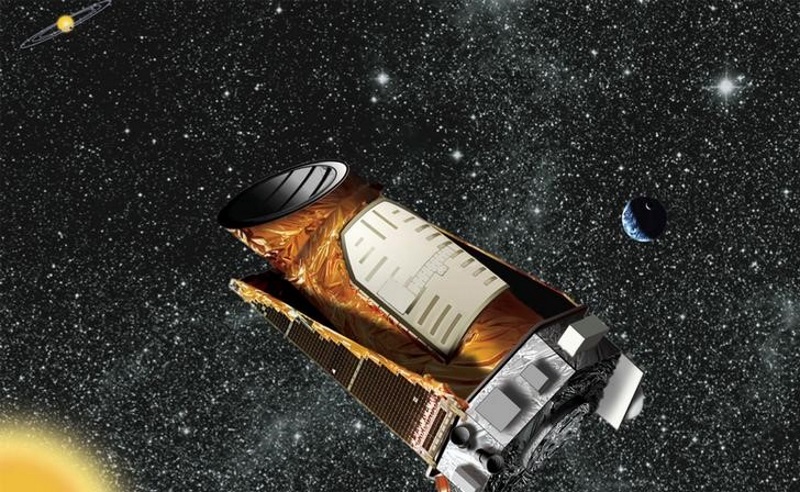- Home
- Science
- Science News
- Record 1,284 Planets Added to List of Worlds Beyond Solar System
Record 1,284 Planets Added to List of Worlds Beyond Solar System

The announcement brings the total number of confirmed planets outside the solar system to 3,264. Called exoplanets, the bulk were detected by Nasa's Kepler space telescope, which searched for habitable planets like Earth.
The new planets were identified during Kepler's four-year primary mission, which ended in 2013, and previously had been considered planet-candidates.
Scientists announcing the largest single finding of planets to date used a new analysis technique that applied statistical models to confirm the batch as planets, while ruling out scenarios that could falsely appear to be orbiting planets.
"We now know there could be more planets than stars," Paul Hertz, Nasa's astrophysics division director, said in a news release. "This knowledge informs the future missions that are needed to take us ever closer to finding out whether we are alone in the universe."
Of the new planets, nearly 550 could be rocky like Earth, Nasa said. Nine planets are the right distance from a star to support temperatures at which water could pool. The discovery brings to 21 the total number of known planets with such conditions, which could permit life.
Kepler looked for slight changes in the amount of light coming from about 150,000 target stars. Some of the changes were caused by orbiting planets passing across, or transiting, the face of their host stars, relative to Kepler's line of sight.
The phenomenon is identical to Monday's transit of Mercury across the sun, as seen from Earth's perspective.
The analysis technique, developed by Princeton University astronomer Tim Morton and colleagues, analyzed which changes in the amount of light are due to planets transiting and which are due to stars or other objects.
The team verified, with a more than 99 percent accuracy, that 1,284 candidates were indeed orbiting planets, Morton said.
The results suggest that more than 10 billion potentially habitable planets could exist throughout the galaxy, said Kepler lead scientist Natalie Batalha, with Nasa's Ames Research Center in Moffett Field, California. The nearest potentially habitable planet is about 11 light years from Earth.
"Astronomically speaking, that's a very close neighbor," she said.
© Thomson Reuters 2016
Get your daily dose of tech news, reviews, and insights, in under 80 characters on Gadgets 360 Turbo. Connect with fellow tech lovers on our Forum. Follow us on X, Facebook, WhatsApp, Threads and Google News for instant updates. Catch all the action on our YouTube channel.
Related Stories
- Samsung Galaxy Unpacked 2025
- ChatGPT
- Redmi Note 14 Pro+
- iPhone 16
- Apple Vision Pro
- Oneplus 12
- OnePlus Nord CE 3 Lite 5G
- iPhone 13
- Xiaomi 14 Pro
- Oppo Find N3
- Tecno Spark Go (2023)
- Realme V30
- Best Phones Under 25000
- Samsung Galaxy S24 Series
- Cryptocurrency
- iQoo 12
- Samsung Galaxy S24 Ultra
- Giottus
- Samsung Galaxy Z Flip 5
- Apple 'Scary Fast'
- Housefull 5
- GoPro Hero 12 Black Review
- Invincible Season 2
- JioGlass
- HD Ready TV
- Laptop Under 50000
- Smartwatch Under 10000
- Latest Mobile Phones
- Compare Phones
- Jolla Phone
- Realme P4x 5G
- OnePlus Ace 6T
- Nubia Flip 3
- Nubia Fold
- OPPO A6x 5G
- Samsung Galaxy Z TriFold
- Poco F8 Ultra
- Asus ProArt P16
- MacBook Pro 14-inch (M5, 2025)
- OnePlus Pad Go 2
- Poco Pad M1
- Just Corseca Skywatch Pro
- Honor Watch X5
- Acerpure Nitro Z Series 100-inch QLED TV
- Samsung 43 Inch LED Ultra HD (4K) Smart TV (UA43UE81AFULXL)
- Asus ROG Ally
- Nintendo Switch Lite
- Haier 1.6 Ton 5 Star Inverter Split AC (HSU19G-MZAID5BN-INV)
- Haier 1.6 Ton 5 Star Inverter Split AC (HSU19G-MZAIM5BN-INV)

















